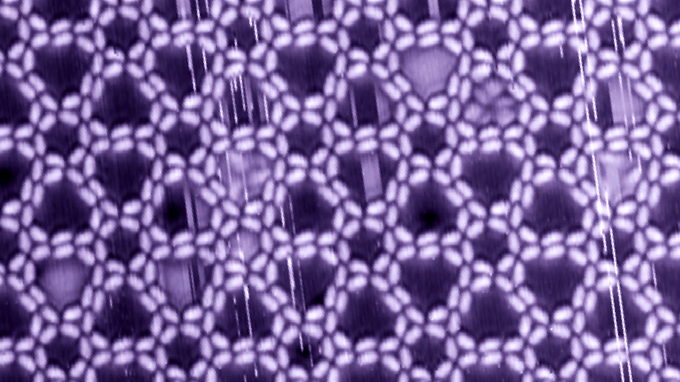Muster mit außergewöhnlichen Eigenschaften
Komplexe chirale, poröse Nanostrukturen aus einfachen linearen Bausteinen
2020-01-16 – Nachrichten aus dem Physik-Department

Unsere genetische Information ist in zwei DNA-Strängen gespeichert, die sich durch einen Selbstorganisationsprozess zur bekannten wendeltreppenartigen Doppelhelix-Struktur zusammenfinden. Wasserstoffbrücken stabilisieren die beiden Stränge dabei und sorgen für die große Stabilität.
Inspiriert von solchen natürlichen „Reißverschlüssen“ suchen Forschende unterschiedlicher Disziplinen und Nationalitäten an der TU München nach neuen Verbindungen, um funktionelle Nanostrukturen zu konstruieren und die Grenzen künstlicher Strukturen zu erweitern.
Baustein für komplexe Nanostrukturen
In den Mittelpunkt ihrer in der Zeitschrift „Angewandte Chemie“ veröffentlichten Untersuchungen stellten die Wissenschaftlerinnen und Wissenschaftler einen neuen Baustein für zweidimensionale Architekturen: eine chemische Gruppe namens Hydroxamsäure-Gruppe.
Mitarbeitende des Lehrstuhls für Proteomik und Bioanalytik in Freising versahen ein stabförmiges Molekül an beiden Enden mit einer Hydroxamsäuregruppe. Auf atomar glatten Silber- und Goldoberflächen wurden damit dann am Lehrstuhl für Oberflächen- und Grenzflächenphysik in Garching molekulare Nanostrukturen erzeugt.
Ein Netzwerk aus Nanoporen
Eine Kombination aus Mikroskopie, Spektroskopie und dichtefunktionstheoretischen Untersuchungen zeigte, dass der molekulare Baustein seine Form in der Umgebung der Trägeroberfläche und seiner benachbarten Moleküle geringfügig verändert. Dies führt zu einer ungewöhnlichen Vielfalt supramolekularer Oberflächenstrukturen, gebildet aus zwei bis sechs Molekülen, die durch intermolekulare Wechselwirkungen zusammengehalten werden.
Nur eine Handvoll dieser Motive sind in 2-D-Kristallen organisiert. Darunter entstand ein beispielloses Netzwerk, dessen Muster an geschnittene Zitronen, Schneeflocken oder Rosetten erinnern. Es verfügt über drei verschiedene Poren. Die kleinsten wären in der Lage, ein einzelnes, kleines Gasmolekül wie Kohlenmonoxid aufzunehmen, die größten hätten Platz für ein kleines Protein wie Insulin.
“Art und Anzahl unterschiedlicher Poren, die durch diese kristallinen 2-D-Netzwerke hervorgebracht werden, sind ein Novum unter den durch molekulare Nanostrukturen erzielten Mosaikstrukturen“, sagt Anthoula Papageorgiou, Letztautorin der Publikation. „Dieses System bietet einzigartige Möglichkeiten für Bottom-up Nano-Templating, die wir weiter erforschen werden.“
Nanokäfige einmal anders
Wie unsere linke und rechte Hand kann die Form zweier spiegelbildlicher Käfigstrukturen nicht überlagert werden. Formen, die so aufgebaut sind, werden nach dem antiken griechischen χείρ (Hand) als “chiral” bezeichnet, aus. Viele Naturstoffe sind chiral und spielen eine entscheidende Rolle für die Biologie.
Unsere Geruchsrezeptoren reagieren beispielsweise sehr unterschiedlich auf die beiden Spiegelbilder des Limonen-Moleküls: Eines riecht nach Zitrone, das andere nach Kiefer. Diese sogenannte chirale Erkennung kann auch darüber entscheiden, ob ein Molekül ein Medikament oder giftig ist.
Die Innenwände der erhaltenen nanostrukturierten Käfige bieten Stellen, an die Gastmoleküle andocken können. In einigen der größeren Poren beobachteten die Forschenden, dass sich drei gleiche Moleküle zu einem chiralen Objekt zusammensetzten. Wie eine Spieluhr-Ballerina ist dieses Objekt bei Raumtemperatur in Bewegung, was zu einem unscharfen Bild führt.
In zukünftigen Arbeiten möchte das Team solche Phänomene weiter erforschen, um sie für die chirale Erkennung und künstliche Nano-Maschinen zu nutzen.
Veröffentlichung
Weitere Informationen
Gefördert wurden die Arbeiten durch das Postdoctoral Council of China, das China Scholarship Council, die International Max-Planck-Research School of Advanced Photon Science, das Forschungsprojekt 2D-INK der Europäischen Union, das European Research Council (Projekt NanoSurfs) und die Deutsche Forschungsgemeinschaft (über den Exzellenzcluster Munich-Centre for Advanced Photonics und eine Heisenberg Professur). Die Berechnungen wurden auf dem Shared Hierarchical Academic Research Computing Network (SHARCNET) und den Cedar-, Graham- und Niagara-Clustern von Compute / Calcul Canada durchgeführt.
- Redaktion:
- Technische Universität München; Dr. Andreas Battenberg
Verwandte Meldungen
- Schalten mit Molekülen – 2018-05-24
- Komplexe Parkettmuster, außergewöhnliche Materialien – 2018-01-22
- Kleine Kunstwerke mit großem Potential – 2016-07-13
- Strom gewinnen mit molekularen Architekturen – 2016-03-02
- Eingesperrte Moleküle offenbaren ihre Thermodynamik – 2015-02-26